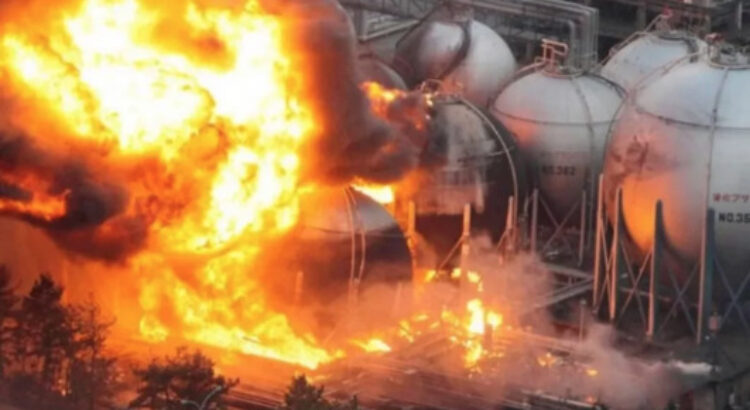Por: Karen Yamanaka
El 11 de marzo pasado marcó el 12º aniversario del gran terremoto del este de Japón, acaecido en esa fecha del año 2011 y seguido de un tsunami que devastó todo el noreste del país y causó la catástrofe nuclear de la central de Fukushima de la Tokyo Electric Power Company (TEPCO). A raíz del siniestro se emitió una cantidad de cesio-137 radioactivo equivalente a 168 bombas de Hiroshima. Tras la revocación de las órdenes de evacuación el año pasado, la población residente pudo regresar finalmente a los municipios de la zona afectada, pero solo lo hizo el 18 %.
A pesar de esta situación, el primer ministro japonés, Fumio Kishida, y la mafia nuclear patrocinada por el gobierno tratan de que los peligrosos reactores nucleares, que ya cuentan 45 años de edad, sigan funcionando durante las próximas décadas y proyectan construir nuevas plantas atómicas. Y Fumio Kishida también pretende destinar la mitad de la recaudación de la tasa de reconstrucción al presupuesto de la vasta expansión militar. Es hora de volver a recordar Fukushima en bien de nuestro futuro.
Recuperación lenta y ansiedad persistente a causa de la radiación
La ciudad de Futaba es el último municipio en el que se ha revocado la orden de evacuación que se decretó a raíz de la catástrofe en la zona afectada. El año pasado se levantó la prohibición de permanecer en esta ciudad que alberga la planta nuclear n.º 1 de Fukushima. Sin embargo, ni siquiera el 1 % de las personas residentes han vuelto a sus hogares. Todavía no se ha especificado el destino final de los suelos contaminados, que se han transportado a espacios de almacenamiento temporal. Además, no se han tomado muestras de los restos de combustible nuclear fundido, que ni siquiera ha sido evacuado.
En esta situación, el gobierno japonés prevé reciclar los suelos contaminados para utilizarlos en obras públicas. Se requerirá alrededor de medio siglo o más para desmantelar la planta nuclear n.º 1 de Fukushima. De aquí al verano se verterán en el océano más de un millón de toneladas de agua tratada procedente de la maltrecha planta nuclear. Se teme que ello causará más perjuicios económicos a la pesca y la agricultura.
El gobierno japonés se resiste al cierre de todas las plantas nucleares
La catástrofe nuclear de Fukushima, así como anteriormente las de Three Miles Island y Chernóbil, nos demostró de nuevo que no podemos controlar los reactores nucleares. Hace doce años, la dosis de radiación en la ciudad de Fukushima fue de 1,2 a 1,3 microsieverts en el momento de la catástrofe, cien veces mayor que la que se dio en Tokio. Y las zonas costeras de la ciudad se encontraron en una situación horrorosa, como si hubieran sido arrasadas por un bombardeo aéreo.
Una vez ocurre una catástrofe nuclear, se precisarán alrededor de medio siglo o más para que la población afectada reconstruya sus vidas, llena de temor por la exposición a la radiación mientras se desmantelan de hecho los reactores nucleares. Y muchos trabajadores estarán condenados a sufrir un grave deterioro de su salud durante muchos años. A pesar de esta situación, Fumio Kishida y la mafia nuclear han comenzado a invocar de nuevo el mito de la seguridad. No solo el gobierno japonés, sino también los gobiernos del este de Asia se resisten a renunciar a la energía nuclear. Esto se debe al fuerte vínculo existente entre la energía nuclear y el armamento nuclear.
Ambiciones hegemónicas con armamento nuclear
La proliferación de centrales nucleares en el mundo puede comportar la proliferación de armas nucleares. Y en caso de guerra, las centrales mismas se convertirían en armas atómicas.
En los últimos años, Japón y sus países vecinos han promovido la generación de energía nuclear so pretexto de estabilizar el suministro energético y mejorar la eficiencia económica. La energía nuclear y las armas nucleares comparten varios rasgos comunes. De hecho, Japón y sus países vecinos ni siquiera han creado un sistema conjunto para hacer frente a otra posible catástrofe nuclear tras la de Fukushima. Esto se debe a que compartir información sobre la generación de energía nuclear puede implicar que se comparta información asociada sobre armas nucleares.
Asia es la principal región del mundo en que más está creciendo especialmente la generación de energía nuclear. Y la mayoría de las plantas nucleares más grandes del mundo se hallan en el este de Asia. El funcionamiento continuo de las centrales nucleares en los países del este asiático permite un abastecimiento continuo de materiales fisibles, que son los componentes fundamentales de las armas nucleares. En Asia Oriental, China es el tercer país del mundo que posee más cabezas nucleares. Este año, Corea del Norte ha pasado de las pruebas con armas nucleares al entrenamiento. Y Corea del Sur, que ha sido declarada enemigo principal por el régimen etno-nacionalista de Kim Jong-un, ha comenzado a avanzar hacia la creación de un arsenal nuclear propio.
La catástrofe nuclear se está fraguando. La existencia misma de las centrales nucleares supone una amenaza para la supervivencia de la humanidad, no solo en esta región, sino en el mundo entero. Justo después de la catástrofe de 2011 en Fukushima, decenas de miles de ciudadanos y ciudadanas japonesas, movilizadas por los movimientos antinucleares, lograron la suspensión temporal de todas las centrales nucleares del país. Sin embargo, en el momento de escribir estas líneas, en Japón vuelven a funcionar siete planteas de energía nuclear. Han pasado doce años desde aquella catástrofe y es hora de avanzar hacia una completa desnuclearización y por una sociedad libre de energía nuclear.
15/03/2023
Karen Yamanaka
Traducción: viento sur
https://vientosur.info/doce-anos-despues-de-la-catastrofe-nuclear-de-fukushima-por-un-mundo-sin-energia-nuclear/









 Users Today : 30
Users Today : 30 Total Users : 35460293
Total Users : 35460293 Views Today : 40
Views Today : 40 Total views : 3419008
Total views : 3419008